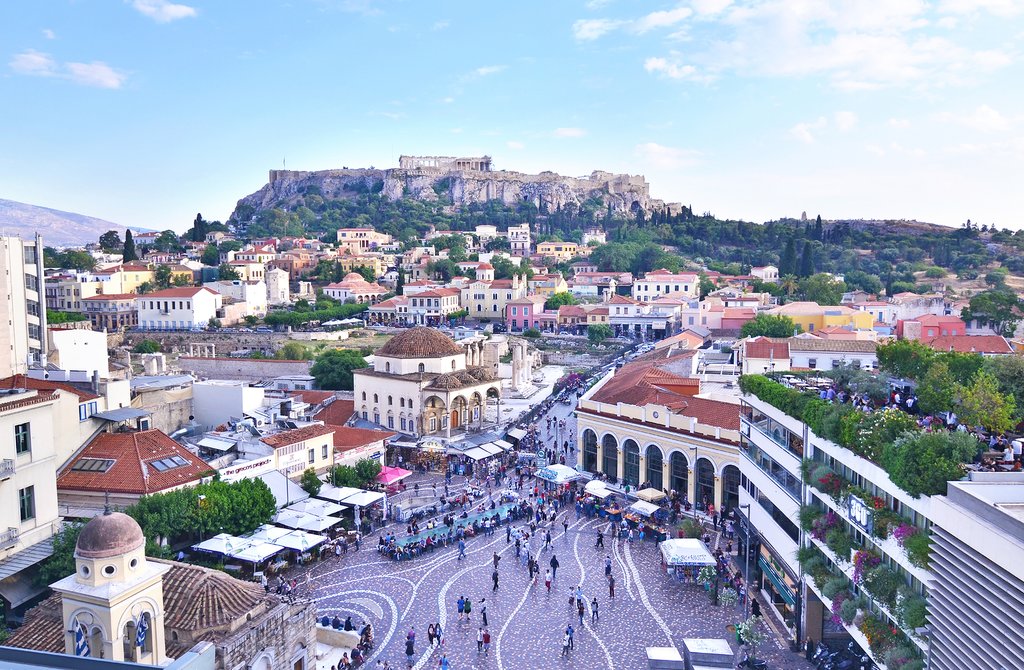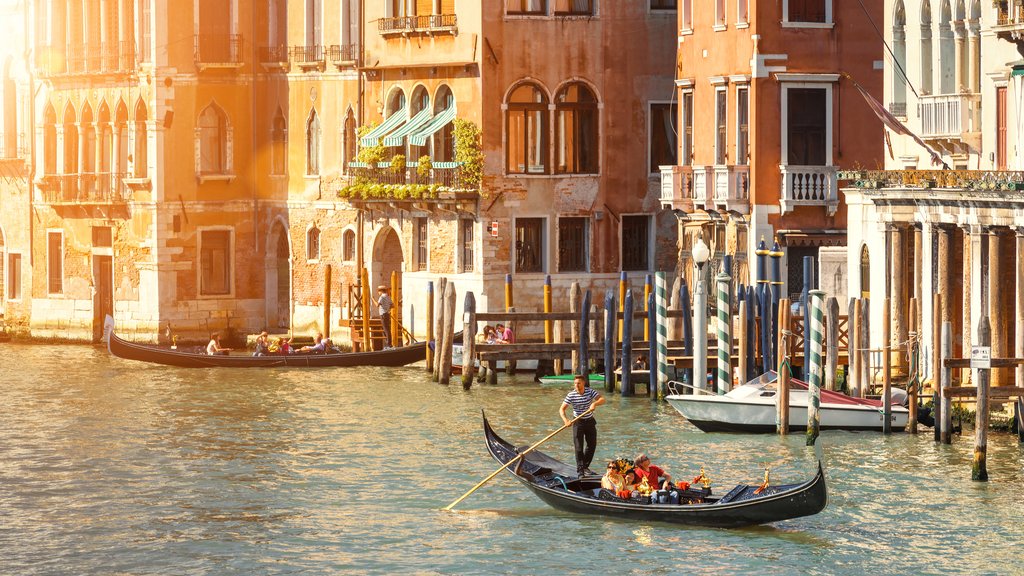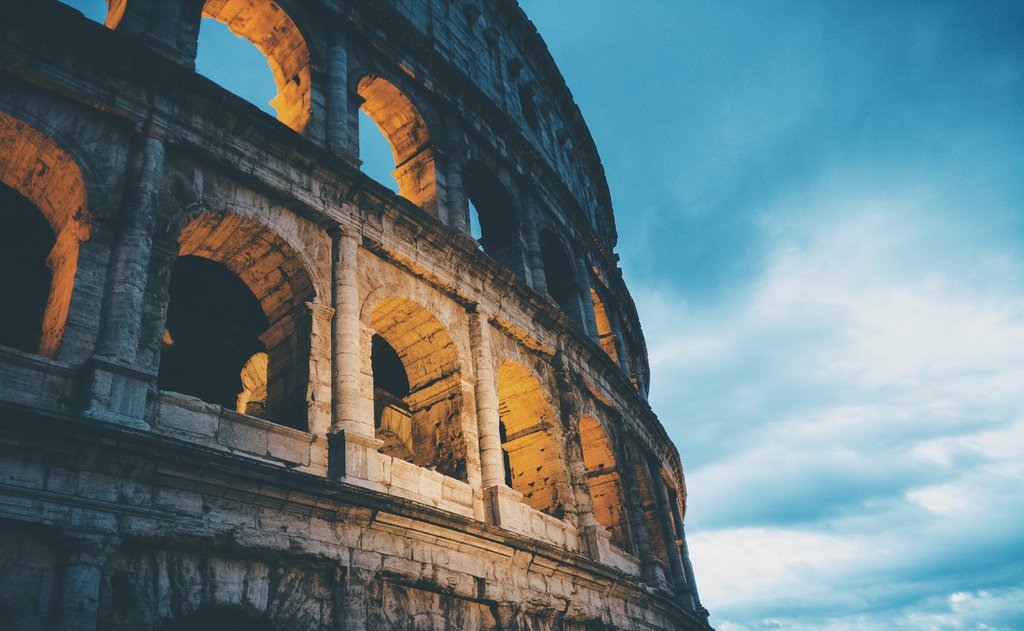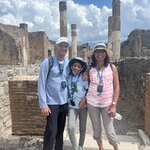Highlights
- Explore the expansive archaeological site of ancient Delphi
- See the Parthenon and the Temple of Athena Nike
- Tour the incredible ruins of Pompeii, preserved by Mt. Vesuvius’ eruption
- Learn about Venetian history and art in the Basilica San Marco
- Walk through the Roman Forum along the ancient Via Sacra
Brief Itinerary
| Day | Highlights | Overnight |
|---|---|---|
| Day 1 | Arrive in Athens | Athens |
| Day 2 | Day Trip to Delphi | Athens |
| Day 3 | Guided Acropolis Visit & Flight to Crete | Heraklion |
| Day 4 | Explore Knossos and Heraklion | Heraklion |
| Day 5 | Flight from Crete to Venice & Gondola Tour | Venice |
| Day 6 | Venice Walking Tour & Train to Rome | Rome |
| Day 7 | Colosseum & Ancient Rome Tour | Rome |
| Day 8 | From Rome to Naples | Naples |
| Day 9 | Pompeii and Mount Vesuvius | Naples |
| Day 10 | Depart Naples |
Detailed Itinerary
Day 1: Arrive in Athens

Welcome to Greece! You'll begin your trip in Athens, home to the iconic Acropolis and so much more. The mythology of this spectacular city precedes it, with towering temples and the ruins of ancient marketplaces rubbing shoulders with lively nightlife, crowded flea markets, and contemporary cuisine. Make the most of your time in the city at some of these spots:
- Check out the views of the can't-miss Parthenon. (Pro tip: The Parthenon is the temple, the Acropolis is the hill.) This temple to Athena has enchanted visitors since its construction was completed in 438 BCE. It's probably the first thing that comes to mind when you think of ancient Greece and is visible from many of the city's high points.
- Stop at the sprawling National Museum for a crash course in ancient iconography. Be sure to seek out the room housing the Antikythera mechanism, essentially an ancient astronomical computer.
- Visit a smaller archaeological site at the Tower of the Winds, then stroll down neighboring pedestrian Aiolou Street to stop at shops and cafes.
- Find your perfect souvenir or sun hat in the busy stalls of the Monastiraki flea market.
- Spend your evening exploring the up-and-coming Pangrati neighborhood or amid the nightlife and mezze of the Psyrri district.
Day 2: Day Trip to Delphi

Today, you'll seek out the oracle during a day trip to the ruins of Delphi, once home to priestesses of Apollo who Ancient Greeks believed could predict the future. After being transferred from your hotel to Delphi (about 2.5 hours from the city), you'll take a guided tour through this sprawling archaeological site, with stops such as the Treasury of the Athenians, the Temple of Apollo, and expansive theater.
Explore the ruins or venture up an ancient footpath once used by worshippers of the god Pan, who started from the temples of Delphi and proceeded to Corycean Grotto for their religious rites, surrounded by the valley of olive trees and views of the Corinthian Gulf and peaks of the Peloponnese on your way.
Outside of the ruins, you'll head to an old section of town that used to serve as the leather tanner's district. One of Greece's last bellmakers keeps his workshop here; if you're lucky, he may be on-site for a visit. Lunch will be served under the plane trees in the town square, with cheeses, Amfissa olives, and traditional home cooking.
Head indoors after lunch to the museum, a short downhill walk away. Wander through its halls to find the bronze Charioteer of Delphi, marble Sphinx of Naxos, and what may be the first recorded notation of a melody once inscribed on the walls of the Athenian Treasury.
You'll be transferred back to Athens in the late afternoon to rest up or spend the evening out and about in the city.
Day 3: Guided Acropolis Visit & Flight to Crete

Today you'll get to experience the mighty Acropolis — ruins of the iconic 5th-century BCE complex located on the rocky hilltop overlooking the city. Take a private guided tour of the entire area with a professional guide who will share the stories of the country's most famous monument. In addition to the iconic Parthenon, dedicated to the city's patron goddess Athena, you'll view and learn about the Propylaea, the Temple of Athena Nike, and the most sacred temple of Erechtheion. Your guide will also provide you with an iPad, which you can use to view the augmented reality displays of the building's original splendor in 3D.
Complement your tour with a trip to the nearby modern Acropolis Museum. Many of the more delicate statues and other artifacts originally found at the Acropolis have been moved here, but you can imagine them in their previous home as you explore the exhibits. Complete your visit with a stop in its cafe for either lunch or a relaxed snack and coffee.
After lunch, head to the historic neighborhood of Plaka, to wander down its many cobbled streets and enjoy refreshments at a local cafe. Then, transfer to the airport to catch your flight to Heraklion, the capital of Crete.
Day 4: Explore Knossos and Heraklion

After breakfast, you'll set off to explore the magnificent Palace of Knossos. This 3,500-year-old Minoan palace is a sprawling maze of royal chambers, grand staircases, storerooms, and workshops. The evocative Bronze Age site is believed to be Europe's oldest city; it flourished for nearly 2,000 years as an economic center, trading with cities across the Mediterranean.
Follow it up with a guided afternoon tour. Stroll through the streets of Heraklion, starting with the Archaeological Museum, home to one of the largest collections of Minoan artifacts in the world. Continue around the old city's medieval streets, with architecture representing the island's Venetian past. Highlights include the elegant arches of the Loggia, now in use as the town hall, and the Koules Venetian fortress along the harbor walls.
A pleasant pedestrian street in the Old Town connects the port area with the Lions' Square and its Venetian fountain. Don't miss "mama's food" at Anchorage Traditional Mezedopolio nearby.
Chat with a local specialist who can help organize your trip.
Day 5: Flight from Crete to Venice & Gondola Tour

Welcome to Italy! Arrive in Venice Airport, then transfer to the city center to your hotel. Settle in and spend the rest of the afternoon exploring the city on your own.
Venice in northern Italy is famous for both industry and tourism. With nicknames like "Queen of the Adriatic", "City of Water", and "The Floating City", it's clear that the city's myriad canals are its main draw. Stretching across 117 small islands in the marshy Venetian Lagoon along the Adriatic Sea, the city has long been a commercial and cultural hub thanks to its strategic placement. Silk, grains, spices, and art were traded through the Middle Ages, making Venice very wealthy.
The city is also famous for its many beautiful historic attractions, such as the Piazza San Marco and San Marco Basilica, the Grand Canal, and the ornate Doge's Palace. The Lido de Venezia is a popular luxury destination that attracts actors, critics, and other cinema industry celebrities.
There's something to be said for the classics. When in Rome, do as the Romans do, and when in Venice, take a gondola tour of its romantic canals. This is the classic ride — a leisurely 30-minute jaunt along Venice's waterways under the power and guidance of a professional gondolier.
It may be a popular tourist activity, but gondolas have been used as transport in the City of Water for well over 1,000 years. This elegant and romantic mode of transport will leave you perfectly content as you leisurely glide on the surface of the water, under Rialto Bridge, and as you pass iconic landmarks like Rialto Square.
After your 30 minutes on the water, you'll hop off the boat and can continue to enjoy Venice on foot however you choose.
For an evening on the town, head to the Cannaregio District, the site of the former Jewish Ghetto. The area is filled with great restaurants, bars, & shops offering kosher Venetian specialties, a Jewish museum, and several tourist-friendly synagogues. Eat and drink your way through regional specialties as you celebrate your first night in Italy. Buon appetito!
Day 6: Venice Walking Tour & Train to Rome

Experience Venice's highlights with a guided walking tour. Start at Piazza San Marco (St. Mark's Square), the heart of the city's cultural and administrative district. Tour Palazzo Ducale (Doge's Palace), a Venetian Gothic palace built as the primary residence for the Doge of Venice in 1340. The palace stands on Piazza San Marco, and its resplendent interior decor and priceless works of art make it a must-see for history and architecture buffs.
The palace is also connected to the next-door prison by the infamous Bridge of Sighs, which has joined the two buildings since the 16th century. The bridge features a small window onto Venice's harbor and earned its grisly name from the prisoners' sighing as they got one last glimpse of the city on their way to execution. While most visitors gather outside the bridge to look in, you'll get the best sense of history from inside the bridge, looking out from the same window as the doomed medieval prisoners.
Adjacent to the palace is the Basilica San Marco, originally the Doge's personal chapel. The building is one of the best surviving examples of Italo-Byzantine architecture and features a stunning collection of Byzantine art, gold mosaics, and exquisite marble floors. Your tour includes a visit inside, where you'll be able to see for yourself the incredible art and architecture that the basilica holds.
Away from Saint Mark's Square, you'll delve deeper into the heart of Venice and away from the crowds. Grab lunch at one of the city's many cafes, then catch an afternoon train to Rome.
Day 7: Colosseum & Ancient Rome Tour

Dive into the history of the Roman Empire with a walking tour of the Colosseum, the world's largest amphitheater. Learn about the lives of some of ancient Rome's most famous and illustrious citizens, such as Julius Caesar, Emperor Augustus, Nero, and the Flavian Emperors who built the Colosseum.
Continue to the Roman Forum, where you'll see excavations dating back 2,000 years, revealing the ruins of temples, squares, religious sites, and other buildings. These were the venues for public speeches, processions, elections, and, of course, gladiator matches. Historians and archaeologists refer to the Roman Forum as one of the most celebrated places in world history, and you'll see why as you explore the grounds.
Cut through the Roman Forum along Via Sacra, where you'll pass by the Temples of Vesta, Antonino, and Faustina. The Basilica Julia and Aemilia, a public meeting house that was commissioned by Julius Caesar, is also here.
Your tour of ancient Rome ends 131 feet (40 meters) above the city at Palatine Hill. From here you'll have incredible city views, with the Forum on one side, Circus Maximus on the other, and the Vatican in the distance. In between, the River Tiber snakes through Rome's historic neighborhoods.
In the evening, you'll have free time to continue exploring Rome. Grab dinner in one of the city's other neighborhoods, such as bohemian Monti, and enjoy the quiet hum of city life as the day comes to a close.
Day 8: From Rome to Naples

Time to say goodbye to Rome! After breakfast, you'll head to the train station and catch your high-speed train down to Naples. The journey takes just over an hour. Naples sits on a bay near the still-active Mount Vesuvius, which buried nearby Pompeii in 79 CE. There's a lot to see and do here, so make the most of your time in the city with these suggested activities:
- Visit the Naples Archaeological Museum to see Roman, Greek, and Renaissance-era ruins, including artifacts from nearby Pompeii.
- Tour the Castel dell'Ovo, a seaside castle located on the former island of Megaride.
- See the 16th-century Museo Cappella Sansevero, which houses thousands of veiled sculptures.
- Go underground to see the network of tunnels and passageways built under the city streets.
- Get outside and see the dormant Solfatara volcano, located a half-hour drive west of Naples.
In the evening, go for a stroll along the Caracciolo e Lungomare di Napoli, a waterfront promenade, then head to the Quartieri Spagnoli, a lively commercial hub, for dinner at a trattoria. On the way, stop at the Toledo Metro station, the Stazione della Metropolitana dell'Arte, to see beautiful mosaic inlays.
Day 9: Pompeii and Mount Vesuvius

Spend the day exploring two of the area's most notable attractions, Pompeii and nearby Mount Vesuvius, on a full-day tour.
Start with a tour of the ruins of Pompeii, a bustling seaside city which was buried underneath 13-20 ft (4 to 6 m) of ash and volcanic debris after the 79 CE eruption of Mount Vesuvius. The ash, which killed many of the city's residents, acted as an archaeological time capsule by preserving many of the city's original buildings and features completely intact.
The walking tour of Pompeii's ancient streets will show off an astonishing number of preserved villas, shops, public buildings, and plazas. Afterward, stop in a local workshop to see the production process for various regional handicrafts, such as cameos and coral jewelry.
After lunch, visit Mount Vesuvius, designated as a UNESCO Biosphere World Reserve. The hiking trails at the top offer unique views inside the crater, as well as panoramic views of the surrounding landscapes and the Tyrrhenian Sea.
In the afternoon, head back to Naples, then spend a relaxing evening enjoying the nightlife.
Day 10: Depart Naples

Time to say goodbye to Italy - for now! Transfer to the airport for your flight home. Safe travels!






